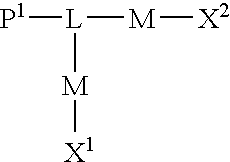Functional biopolymer modification reagents and uses thereof
a technology of biopolymer and reagent, which is applied in the field of preparation of reagents and methods for the preparation of modified biopolymers, can solve the problems of insufficient criteria, inability to meet all requirements, and limited methods in which a functional moiety can be incorporated into an oligonucleotide during its synthesis on a solid support, so as to increase the resistance of enzymatic degradation and accurate determination of base composition
- Summary
- Abstract
- Description
- Claims
- Application Information
AI Technical Summary
Benefits of technology
Problems solved by technology
Method used
Image
Examples
example 1
Preparation of an Aldehyde Phosphoramidite
[0272]As shown in FIG. 3, succinimidyl 4-formylbenzoate (3-1; 6.06 g, 24.5 mmol, 1 eq.) was dissolved in dioxane (60 mL). To this, a solution of 6-aminohexanol (3-2; 3 g, 25.7 mmol, 1.05 eq.) in H2O (10 mL) was added dropwise. Thin layer chromatography indicated that the reaction was complete after 3 hours stirring at room temperature. The reaction mixture was concentrated and the residue was suspended in ethyl acetate. The product was isolated by filtration. The product was recrystallized from ethyl acetate. The mother liquor was concentrated and a second crop of produce was isolated by filtration to give a total of 3.4 grams of desired aldehyde alcohol 3-3.
[0273]Alcohol (3-3; 3.3 g, 13 mmol, 1 eq.) was evaporated from pyridine (4×20 mL) and suspended in dry CH2Cl2 (40 mL). Diisopropylammonium tetrazolide (1.1 g, 6.6 mmol, 0.5 eq.) was added to the reaction mixture neat. Amidite (3-4; 4.4 mL, 15 mmol, 1.1 eq.) was added dropwise over 10 min...
example 2
Incorporation of an Aldehyde Amidite on the 5′-terminus of Oligonucleotide During Solid Phase Synthesis
[0274]A 25 mer phosphodiester DNA oligonucleotide with sequence 5′ ttt-ttt-tag-cct-aac-tga-tgc-cat-g 3′ was synthesized on a PerSeptive Expedite 8909 instrument using the standard protocol. A small amount of beads were removed for use as a precursor (DMT-off) standard. A 0.1 M solution of the aldehyde phosphoramidite from Example 1 was prepared by dissolving the solid in dry acetonitrile (less than 20 ppm water). The aldehyde amidite was coupled to the 5′ end of the oligonucleotide by syringe using a manual syringe coupling technique. The coupling time was 15 minutes.
[0275]The modified oligonucleotide and the precursor standard were deprotected with concentrated ammonium hydroxide for 15 hours at 55° C. Following the deprotection, the ammonium hydroxide solution was transferred from the cpg and dried in a speed vac concentrator. Each crude sample was analyzed on a 15% acrylamide de...
example 3
Procedure for Conversion Alcohols to Amidites
[0277]To a solution of the alcohol (1 equiv.) in dry acetonitrile is added diisopropylammonium tetrazolide (2.5 equiv.) followed by the addition of 2-cyanoethyl-N,N,N′,N′-tetraisopropylphosphorodiamidite (1.2 equiv.). The reaction mixture is stirred at room temperature until complete (TLC: silica gel, ethyl acetate / hexanes / triethylamine (47.5 / 47.515)). The reaction mixture is concentrated and redissolved in a minimal amount of ethyl acetate and purified by flash chromatography (silica gel). The column is packed with ethyl acetate / hexanes / triethylamine (47.5 / 47.5 / 5) and eluted with ethyl acetate / hexanes / triethylamine (49.5149.5 / 1). Fractions containing the product are combined and dried to yield the desired phosphoramidite. The purity and structure of the product is confirmed by 1H NMR and 31P NMR.
PUM
| Property | Measurement | Unit |
|---|---|---|
| pH | aaaaa | aaaaa |
| pH | aaaaa | aaaaa |
| pH | aaaaa | aaaaa |
Abstract
Description
Claims
Application Information
 Login to View More
Login to View More - R&D
- Intellectual Property
- Life Sciences
- Materials
- Tech Scout
- Unparalleled Data Quality
- Higher Quality Content
- 60% Fewer Hallucinations
Browse by: Latest US Patents, China's latest patents, Technical Efficacy Thesaurus, Application Domain, Technology Topic, Popular Technical Reports.
© 2025 PatSnap. All rights reserved.Legal|Privacy policy|Modern Slavery Act Transparency Statement|Sitemap|About US| Contact US: help@patsnap.com



